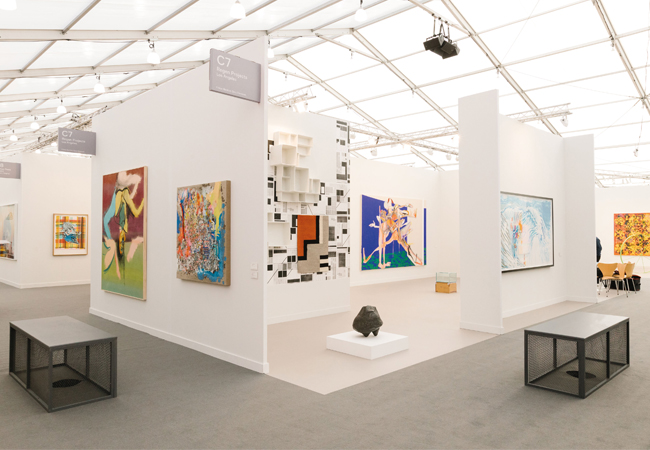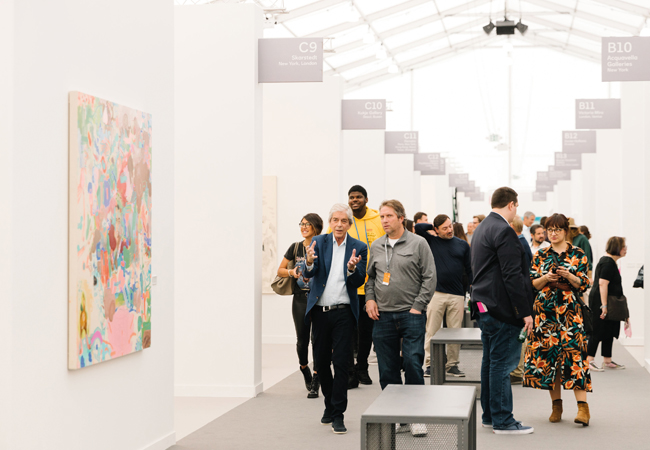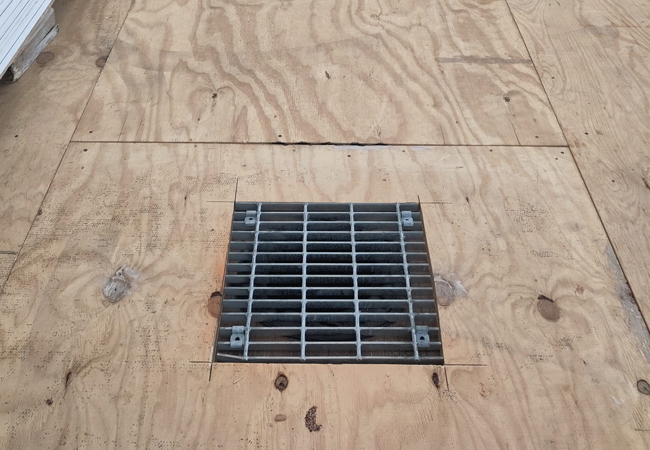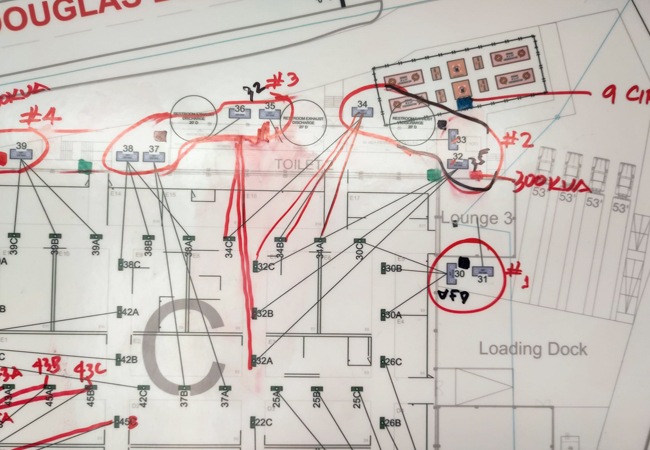
A Frieze bench, with its metal mesh sides, in situ at Frieze Los Angeles (before rectangular grilles were used)
There is always a sense of trepidation on the first day of Frieze Los Angeles, the city’s most prestigious art fair. Hundreds of dealers are hoping to persuade Hollywood’s rich and famous to buy art from their collections, and day one is when the biggest deals take place. A successful day selling to art-loving stars such as Jay-Z, Leonardo DiCaprio or Brad Pitt can make a gallery’s year.
Keeping sellers and collectors comfortable as they negotiate million-dollar art sales is of paramount importance. Frieze Los Angeles is held in a series of temporary tented structures, so controlling the rarefied environment was a particularly demanding challenge for consulting engineer mstep.
‘The galleries can be super-sensitive to environmental conditions,’ says founder of mstep Aleksandra Sasha Krstanovic FCIBSE. ‘Dealers are trading very expensive collections with delicate people. They don’t want to be sitting around getting hot and flustered. We have to be aware of how the temperatures affect the clients and their business.’
To ensure every gallery at Frieze sits within a comfortable temperature band, Krstanovic has a small army of helpers, with handheld infrared thermometers, recording whether spaces are within an acceptable range.

mstep has to be aware of rising temperatures when crowds gather
Variations in temperature can be caused by the position of the sun, the proximity of doors and, in some cases, by the biggest celebrities on the planet. ‘Last year, we had Beyoncé visit the show, and it was amazing to see the surge of heat move across the space as the crowds followed behind her,’ remembers Krstanovic. ‘We had to guess where she was going to go next and push the air con up to cool everything down.’
The history of Frieze
Frieze is one of the contemporary art world’s most influential trade fairs, attracting international galleries to exhibit and sell at exhibitions in London, Los Angeles, New York and Seoul. It was set up in London in 2003, before expanding to New York in 2012, Los Angeles in 2019, and Seoul last year.
While the New York and Seoul fairs are held in permanent exhibition centres, the London and LA shows take place in tented structures. In LA, the tents are set up by temporary events specialist Production Glue. It takes four weeks to build the site, in an operation that, according to Krstanovic, ‘requires a remarkable amount of coordination’.
Frieze first came across Krstanovic’s desk while she was working at Aecom as the arts and culture lead, and she took the project with her when she founded mstep, an MEP engineering and environmental consultancy in London. ‘For someone who has an interest in art, Frieze is just phenomenal,’ she says.
Before signing a contract, Krstanovic says a lot of technical design work was undertaken to remove any risk. ‘The main thing was to agree a floating setpoint with Frieze, which we agreed would be 26oC when the external is not outside of its standard extremes – which, in LA, is 33oC. If it goes to 40oC, we are allowed to go higher,’ she says.
The decision to allow for a slight temperature fluctuation makes significant savings in cooling loads. ‘We don’t need to maintain a temperature of 24oC at all times; if it rises to 26oC, let it go to 26oC. The closer we try to control temperatures, the more energy intensive it gets.’
The focus of the Frieze environment is on comfort for visitors, rather than the art. ‘Art doesn’t like big fluctuations or surprises; at a reasonably steady temperature in a tent for five days, it will be fine – art is not as sensitive as many people believe,’ Krstanovic says.
Temperature control in many temporary events features a conventional overhead fabric duct system with air blown downwards. This is the system used at Frieze London, which took place last month. However, this method is not appropriate in more extreme climates, Krstanovic says, as the 12m height of the tents means a large area has to be heated or cooled before the system affects the 2m high space in which the people are located. In LA, the show takes place in the spring, which means conditions typically vary between 32oC during the day and 4oC in the evening.
To enable air to enter the tent at floor level, mstep made use of the elevated area under the tent structures and designed a system with a network of ducts connected to externally mounted direct expansion air handling units (AHUs) with electric heaters. The air enters the tent through holes cut into the structure’s wooden floor, which are then covered by mesh cages that double as benches.
we don’t need to maintain 24ºC… the closer we try to control temperatures, the more energy intensive it gets
‘When we saw the opportunity to use the space underneath to move air through ducts, that’s when the idea of the Frieze bench was born,’ says Krstanovic. ‘We presented Frieze with the idea, and they asked how many we needed and said they’d sort it out.’
The benches are spaced at approximately 3m centres and the air enters at up to 800 litres per second at temperatures of between 13oC and 35oC. It travels upwards from the grille to the underside of the bench, where it is dispersed sideways through the metal mesh, which acts as support for the bench.
Each AHU is connected, via a duct, to three benches, which enables mstep to vary temperatures and airflows according to the requirements of each gallery.
‘Temperature can vary across the tent, depending on the flow of the crowd, the position of the sun, and the proximity to the door,’ says Krstanovic. ‘The controllable zones enhance flexibility. While each AHU can only have one environmental regime, having many units means temperatures can be altered between galleries.’
Mstep has learned to protect galleries from cold draughts that are close to air outlets. ‘If there is a gallery in front of the bench, it can be uncomfortable if there is a lot of cool air, and we can include dampers in the supply grilles to moderate flows,’ says Krstanovic.
Since the first LA Frieze, the design of the bench has evolved aesthetically to complement the gallery spaces. Extra mesh in the design makes the seats appear more transparent and congruous, and they are now collapsible, making them easier to store.
In the frame

A grille placed over a vent cut into the wooden floor
Originally at LA Frieze, the holes cut into the wooden floors to enable air to enter the tent were round, but these could not be fitted with standard grilles. This meant people had to stand guard over the openings while precious artwork was manoeuvred into position.
Thanks to a suggestion from Production Glue, square openings are now made, which can be fitted with metal grilles during construction, eliminating the need for human guard rails.
The carpet is laid after the artwork has moved into position, to prevent it from being damaged. The final task before the fair opens is to cut holes in the carpet to expose the grilles and then move the benches on top. ‘It’s a big operation,’ says Krstanovic.
The team at mstep has also come up with a simple, yet incredibly effective, mechanism for regulating the temperature levels within the tent, as Krstanovic explains. ‘We walk around the tent with £30 thermometer guns, taking readings. If temperatures are too high or low, we use WhatsApp groups to talk to the system operatives, who manually tweak the systems’.
The biggest swings in temperature are caused by the crowds – generated by mega celebrities or otherwise. ‘At the start, people arrive at the same time, bringing in body temperature – that’s when we really have to start playing around with the system,’ says Krstanovic, who adds that they look at weather forecasts to predict how temperatures in the tent will change.
‘It’s incredible what you can do with manual predictive controls. Even in London, with this conventional single overhead duct system, it’s really successful.

The AHUs each serve three benches eg 30C, 30B and 30A
‘We’ve discovered that between 20.5oC and 21.5oC is ideal in London. By measuring and communicating the temperature during the day, our teams keep the tent between this 1.5oC band. You don’t need a super-sophisticated system to do it – just people power. Due to the temporary nature of the fairs, human monitoring and control is most effective,’ she says. Frieze London also occasionally requires air conditioning – including last month as October was mild.
Teams of six or seven people are on rotation during the day, says Krstanovic. They don’t have to be engineers, but they do need to be conscientious about what they are doing, she says. ‘The tent’s a bit like a sailboat – things go very wrong very quickly. Once temperatures start getting uncomfortable, it’s really hard to bring them back. You can’t let it go – it’s relentless,’ she adds.
Frieze London
mstep has just completed working on Frieze London, which took place from 11-15 October. The heating and cooling strategy at the event in Regent’s Park is relatively simple compared with the one for LA. The mild conditions in early autumn means a conventional overhead ducting system is used.
In London, the tent needs to be pre-heated before the event opens at 10am. Then, depending on the conditions, the heating is turned off, leaving only the ventilation running, unless cooling is required – which is was last month. When the sun starts to go down, the heating returns as the event continues until early evening.
Krstanovic believes continual monitoring and system optimising should be happening in all buildings. ‘Around 90% of all buildings have sufficient hardware to do this. It’s all easy, but we need building management assistance to help FM [facilities management] teams to operate the systems correctly,’ she says.
‘Operational carbon is what we building services engineers deal with – it’s not glamorous, but that’s where the major opportunities are. By monitoring and controlling buildings properly, we can cut energy consumption by 40%.’
This will please green-minded celebrities such as DiCaprio and Jane Fonda, who have visited LA Frieze. The 2023 event was deemed a success, with dealers reporting a ‘fruitful fair with a contagious energy’. A number of works sold for more than $1m, with Mark Bradford’s painting Shall Rest in Honor There topping the sales list at $3.5m.
In London last month Damien Hirst sold all 12 of his paintings on show and Tracey Emin sold two paintings with a combined value of over £2m. While buyers snapped up the hottest artists, Krstanovic and her team ensured that everyone was able to appreciate the Frieze fair in optimal environmental conditions.
